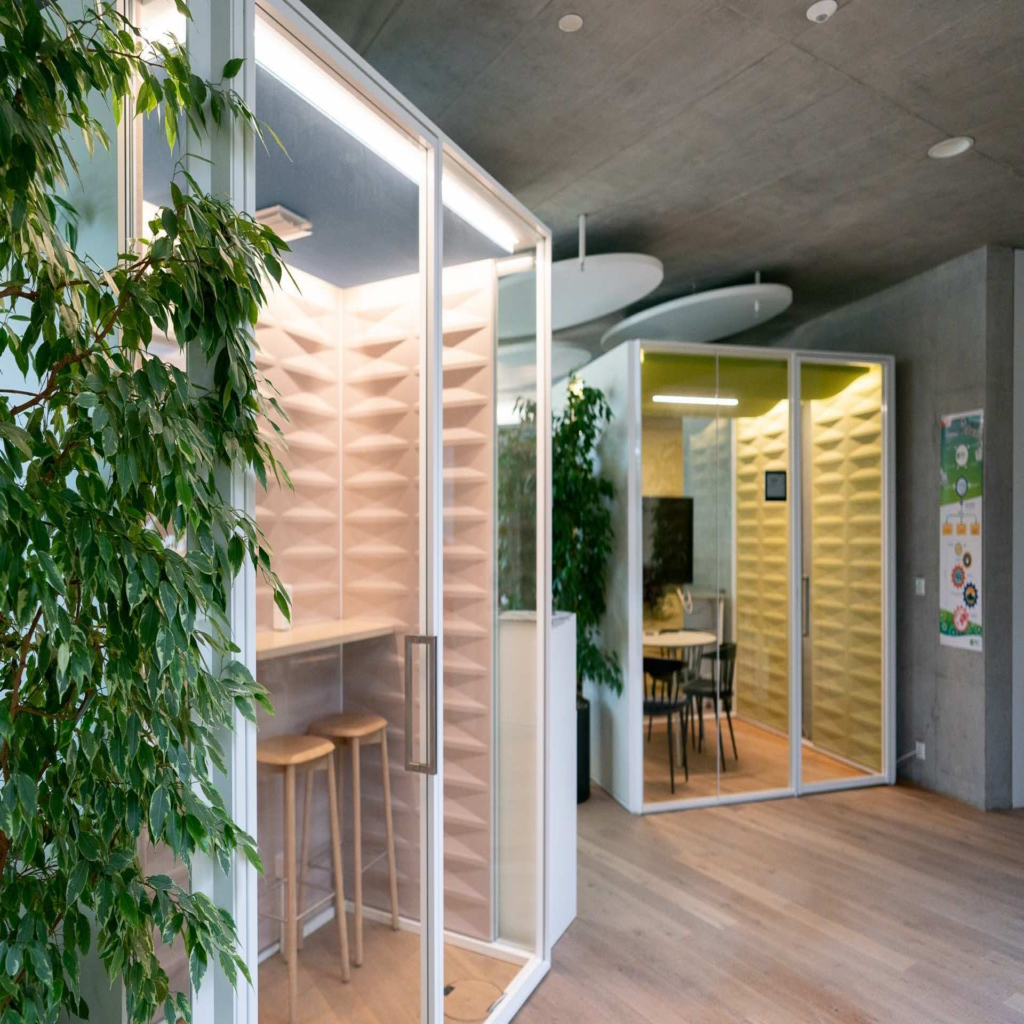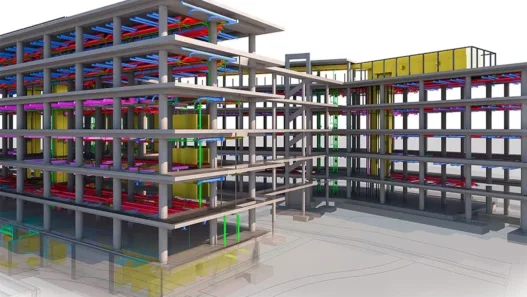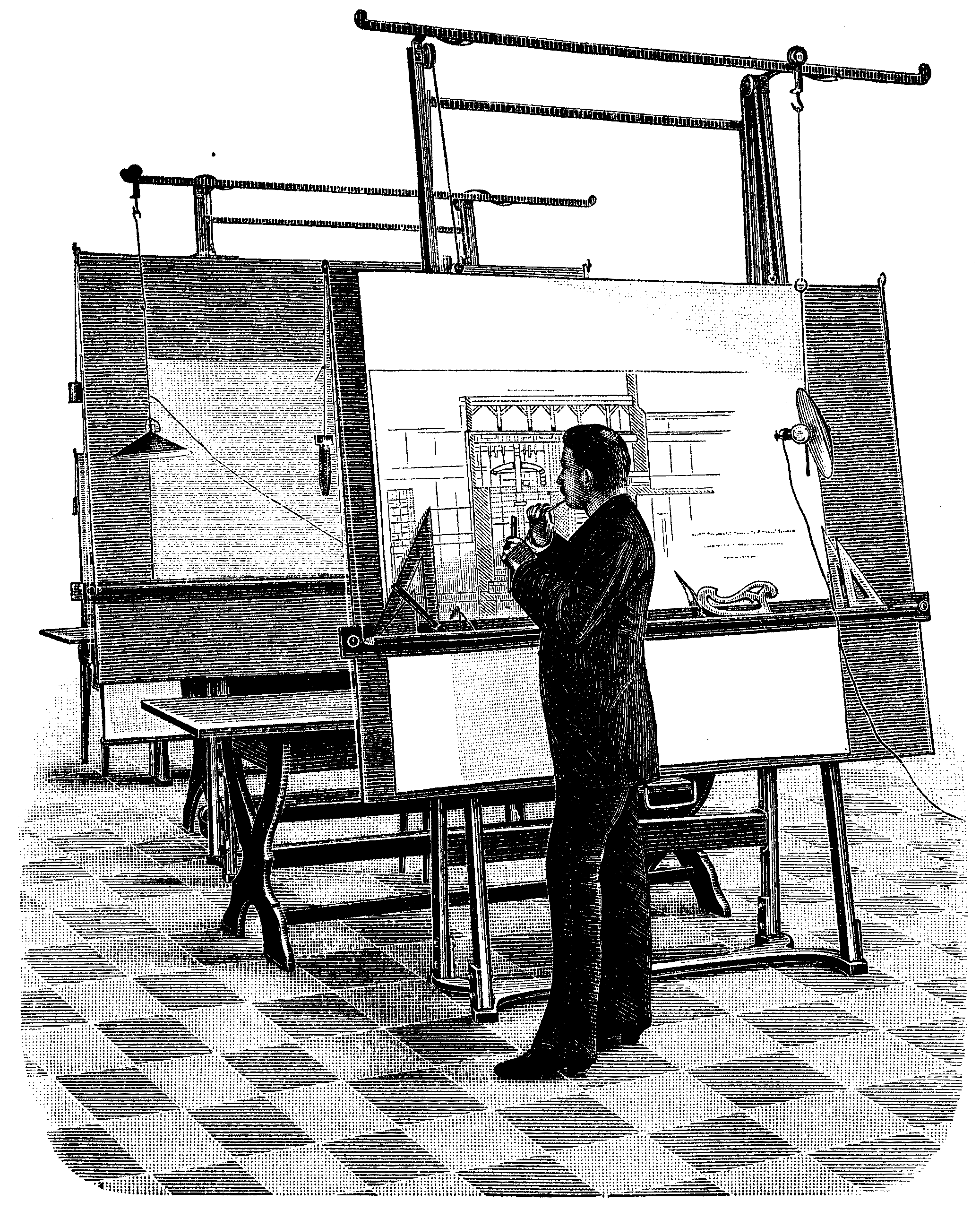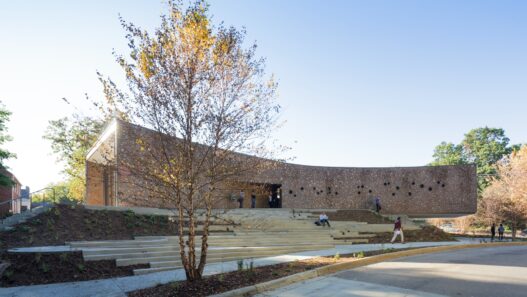Acoustic design is a fascinating and important aspect of architecture that focuses on creating spaces with optimal sound quality. Whether it is a concert hall, a classroom or a home, how sound moves and interacts within a space can significantly affect how we experience our surroundings. This field combines art and science, ensuring that our built environment also supports auditory experiences.

As we enter the world of acoustic design, we will explore its definitions, importance, historical context, basic principles and the materials that play a crucial role in shaping sound.
Definition of Acoustic Design
At its core, acoustic design is the practice of managing sound within a built environment. It involves understanding how sound waves behave, how they are absorbed, reflected and transmitted, and how these properties can be manipulated to achieve desired acoustic results. Acoustic design addresses various elements including speech intelligibility, sound clarity and overall sound quality. It is about creating environments where sound, whether through music, speech or silence, enhances the experience of a space.
The Importance of Acoustics in Architecture
The importance of acoustics in architecture cannot be overstated. Poor acoustic design can lead to either overly noisy or eerily quiet environments, both of which can undermine the intended use of a space. In schools, for example, good acoustics are vital for effective communication and learning, as students need to hear their teachers clearly. In theaters, sound needs to be evenly distributed so that every audience member can enjoy the performance. Also, in open offices, proper acoustic design can improve productivity by minimizing distractions. In essence, effective acoustic design contributes to comfort, functionality and overall user satisfaction in a variety of environments.
Historical Context of Acoustic Design
The practice of acoustic design has a rich history dating back to ancient civilizations. The Greeks and Romans understood the importance of sound in their amphitheaters and public spaces, using natural materials and strategic shapes to enhance acoustics. The great cathedrals of the Middle Ages also exhibited advanced acoustic principles, with high ceilings and curved surfaces designed to amplify sound during services. As technology evolved, so did the understanding of sound. In the 20th century, with the rise of modern architecture, acoustic design became a specialized field that integrated scientific research with architectural creativity. Today, architects and acousticians work closely together, using advanced modeling techniques and materials to create beautifully resonant spaces.
Basic Principles of Sound Control
The basic principles of sound control in acoustic design revolve around three main concepts: absorption, reflection and diffusion. Absorption involves using materials that absorb sound energy and reduce echoes and reverberation. This is particularly important in areas where clarity is crucial, such as recording studios or auditoriums. Reflection, on the other hand, refers to the bouncing of sound waves off surfaces and can be manipulated to improve sound quality. For example, strategically placed reflective surfaces can help distribute sound evenly. Finally, diffusion helps create a more balanced acoustic environment by dispersing sound waves in different directions. Together, these principles guide designers in creating spaces that meet specific auditory needs.
Acoustic Materials Overview
Acoustic materials are the backbone of effective acoustic design. They come in a variety of forms, each serving different purposes. Soft materials such as carpets and acoustic panels absorb sound, minimizing echoes and improving clarity. Hard materials such as concrete and glass can reflect sound, making them useful in certain contexts, but they need to be carefully managed to avoid excessive noise. Furthermore, innovative materials such as sound-absorbing ceiling tiles and specialized wall coverings are increasingly being used to improve acoustics without compromising aesthetic appeal. Understanding these materials and their properties enables architects to make informed decisions that lead to better sound experiences in their designs.
In conclusion, acoustic design is a vital component of architecture that influences how we experience sound in our environments. By understanding its principles, historical context and relevant materials, architects can create spaces that resonate with beauty and functionality, and improve our daily lives through carefully designed acoustics.
Understanding Sound Behavior
Sound is an integral part of our environment and influences how we experience spaces. Whether it is the serene whisper of nature or the bustling noise of a city, understanding how sound behaves in buildings is crucial for architects, designers and anyone interested in creating harmonious spaces. This research explores how sound travels, the different types of sound we encounter, the dynamics of sound reflection and absorption, the methods we use to measure sound levels, and the important influence of room shape and size on acoustics.
How Does Sound Travel?
Sound travels through different media such as air, solids and liquids. When an object vibrates, it creates sound waves that propagate in all directions. These waves consist of compressions and rarefactions, or areas of high and low pressure. In a building, sound can travel rapidly along walls, floors and ceilings, often reaching areas far from its source.
The speed of sound is affected by several factors, including temperature and the environment through which it travels. For example, sound travels faster in warmer air than in colder air. This principle is very important in architectural design, especially in large venues such as concert halls or theaters, where understanding how sound will move can greatly enhance the overall experience of the audience.
In practical applications, designers use this knowledge to create spaces that enhance or control sound transmission. In a recording studio, for example, materials and layouts are specially selected to optimize sound transmission and avoid unwanted noise interference.
Types of Sound in Buildings
In the context of architecture, sounds can be divided into two main types: airborne sounds and impact sounds. Airborne sounds include sounds moving through the air, such as voices, music and traffic. These sounds can vary significantly in frequency and volume and can affect how they are perceived in different spaces. For example, a room designed for musical performance needs to accommodate a wide range of frequencies to provide clarity and depth.
Impact sounds, on the other hand, occur when force is applied to a surface, causing vibrations. Examples include footsteps on a floor or the slamming of a door. These sounds can be particularly disturbing in multi-unit buildings, where they can travel through floors and walls. Understanding these types of sounds helps architects and acousticians design spaces that minimize noise pollution and increase comfort.
Sound Reflection and Absorption
Sound waves can either be reflected or absorbed when they encounter surfaces. Reflection occurs when sound bounces off hard surfaces such as concrete or glass, which can increase noise levels in an area. This reflection can create echoes, especially in large, empty spaces, making it difficult to communicate or enjoy sound clearly.
Conversely, absorption occurs when materials absorb sound waves, preventing them from bouncing back. Soft materials such as carpets, curtains and acoustic panels are excellent at absorbing sound. In the design of spaces such as offices or classrooms, using absorbent materials can help reduce noise levels and improve overall acoustics. This balance between reflection and absorption is crucial to achieve the desired sound quality in any space.
Measuring Sound Levels
To effectively manage sound in a building, it is essential to accurately measure sound levels. This is usually done using a sound level meter that measures sound in decibels (dB). Understanding sound levels is important to ensure compliance with building codes and regulations, especially in residential areas where noise regulations may apply.
In practical scenarios, sound level measurements can guide architects in determining the necessary sound insulation materials and designs. In a hospital, for example, low sound levels are critical for patients’ recovery, so careful measurements can inform strategies to create a quieter environment.
The Role of Room Shape and Size
The shape and size of a room play a very important role in its acoustics. Different geometric configurations can affect how sound waves propagate through the space. For example, a circular room can distribute sound more evenly than a rectangular room, which can create dead spots where sound is weak or distorted.
Also, larger rooms tend to have longer reverberation times, which can strengthen certain sounds but make speech less intelligible. Auditoriums and theaters are therefore often designed with specific dimensions and materials to optimize sound quality for performances. Understanding the interaction between room dimensions and sound behavior enables architects to create spaces that are truly suitable for their intended use.
In conclusion, sound behavior in buildings is a multifaceted topic that encompasses how sound travels, the types of sound encountered, reflection and absorption dynamics, sound measurement techniques, and the influence of room shape and size. By understanding these concepts, architects and designers can create spaces that contribute to the overall atmosphere and comfort of the environment by enhancing the auditory experience.
Acoustic Design Strategies
Acoustic design is an important aspect of architecture that focuses on controlling how sound interacts with spaces. Good acoustic design not only enhances the auditory experience within a building, but also contributes to the overall comfort and functionality of the environment. It involves a range of strategies that consider everything from the layout of a space to the materials used in construction. In this research, we will explore various acoustic design strategies that architects can use to create acoustically optimized spaces.
Space Planning and Orientation
Site planning and orientation play a crucial role in acoustic design. When architects consider the geographical and environmental context of a building, they can significantly influence its sound behavior. For example, positioning a building away from busy roads can minimize traffic noise, while strategically orienting it to take advantage of natural soundscapes such as water sounds or rustling trees can enhance the overall atmosphere.
Furthermore, the topography of a site can act as a natural sound barrier. For example, hills or natural vegetation can absorb and deflect sound, creating a more peaceful environment. Thoughtful site planning encourages a sense of connection with the surrounding landscape, making the building more in tune with its surroundings.
Zoning for Sound Control
Zoning is another important strategy in acoustic design. It involves organizing spaces within a building according to their sound requirements and function. For example, noisy areas such as gymnasiums or meeting rooms should be located away from quieter areas such as offices or bedrooms. This spatial separation minimizes sound transfer and increases the usability of each space.
In multi-use buildings, careful zoning can lead to the creation of buffer zones such as corridors or atria that further reduce sound transmission. Effective zoning also supports the functional flow of the building, allowing occupants to move between spaces without interruption. Organizing sound-sensitive areas in this way creates a more pleasant and productive environment.
Design for Different Spaces
Each space within a building has unique acoustic needs that must be addressed during the design process. For example, concert halls require careful consideration of sound reflection and reverberation to enhance musical performances, while offices benefit from sound absorption to minimize distractions and maintain privacy.
Designing for these different acoustic requirements requires selecting appropriate materials, shapes and configurations. For example, the use of curved surfaces in a performance space can help redirect sound waves, while the use of soft furnishings in an office can absorb noise. Understanding the specific needs of different spaces allows architects to create environments that suit their intended use, increasing both functionality and comfort.
Combining Natural Elements
Incorporating natural elements into architectural designs can not only beautify a space, but can also significantly improve its acoustic properties. Elements such as trees, water features and landscaped gardens can act as natural sound barriers. They create a calmer environment by absorbing and deflecting noise.
In addition, the use of natural materials such as wood and stone can affect sound quality. These materials often have suitable acoustic properties that can enhance the auditory experience within a building. For example, wooden surfaces reflect sound in a warm and pleasant way, making them ideal for spaces such as a café or community center. By blending natural elements with design, architects can create acoustically effective spaces.
Use of Acoustic Barriers
Acoustic barriers are physical structures designed to block or absorb sound and are an important component of effective acoustic design. These barriers can take various forms, from walls and fences to sound-absorbing panels and ceilings. Their placement is critical, as they need to be strategically located to reduce noise from external sources such as highways or railroads.
In urban environments where noise pollution is common, acoustic barriers can provide a quiet refuge. For example, residential areas near busy streets often benefit from sound walls that reduce traffic noise and improve residents’ quality of life. Also, the use of acoustic panels in commercial spaces can help manage sound levels, ensuring that conversations and activities do not interfere with each other. By thoughtfully integrating acoustic barriers into architectural design, architects can create calmer and more functional environments.
In conclusion, acoustic design strategies encompass a wide range of techniques that can greatly enhance the comfort and usability of spaces. By understanding and applying these strategies, architects can create environments that foster a harmonious relationship with sound.
Materials and Technologies
The world of architecture is a living tapestry woven from a variety of materials and technologies. These elements not only shape the physical environment, but also influence how spaces feel and function. Among the many aspects of building design, acoustic insulation is crucial as it addresses the often overlooked importance of sound in our built environment. This section will cover acoustic insulation materials, soundproofing techniques, innovations in acoustic technology, real-world case studies and the delicate balance between aesthetics and functionality.
Acoustic Insulation Materials
Acoustic insulation materials are designed to create a more comfortable and peaceful environment by reducing sound transmission between spaces. These materials can be classified into several categories, including porous absorbers, barriers and mass loaded vinyl.
Porous absorbers, such as foam panels and mineral wool, work by trapping sound waves and converting them into small amounts of heat. This process is crucial in environments where echo or reverberation can disrupt communication, such as concert halls or recording studios. Barriers, on the other hand, focus on blocking sound transmission. Heavy materials such as concrete and lead are effective in this regard, making them common in the walls of residential buildings near busy streets.
Real-world applications of these materials range from urban apartments designed to minimize street noise to schools equipped with sound-absorbing panels that enhance learning by reducing distractions. As architects and builders increasingly recognize the importance of sound in our daily lives, the use of acoustic insulation materials is becoming standard practice in construction.
Sound Insulation Techniques
Soundproofing techniques encompass a variety of strategies that architects and builders use to improve the acoustic performance of a building. One popular method is decoupling, which involves separating two surfaces to prevent sound vibrations from passing through them. This technique is often used in walls and floors where noise reduction is required.
Another effective approach is the use of sound dampening materials that can be incorporated into walls, ceilings and floors. These materials absorb sound energy and prevent it from bouncing around the room. Furthermore, installing double-glazed windows can significantly reduce noise from outside, making homes and offices quieter.
In practical terms, these techniques are often applied in urban environments where noise pollution is common. For example, residential projects near airports or train stations often include advanced soundproofing measures to ensure that living spaces remain calm. By applying these soundproofing techniques, designers create environments that promote productivity, relaxation and overall well-being.
Innovations in Acoustic Technology
The field of acoustic technology is constantly evolving due to advances in materials science and engineering. One promising innovation is the development of smart acoustic panels that can adapt to changing sound environments. These panels use sensors to detect noise levels and adjust their properties accordingly, increasing sound absorption where necessary.
Another exciting area is the use of nanotechnology to create lightweight, high-performance acoustic materials. These materials can provide excellent sound insulation while being easy to install and aesthetically pleasing. Researchers have developed nanofiber-based materials that are environmentally friendly and contribute to sustainable building practices.
These innovations are changing the way architects approach acoustic design. They allow for more creativity in integrating sound management into buildings without compromising design integrity. As a result, we are seeing a growing trend towards multifunctional spaces that prioritize both form and function, ultimately improving the quality of life for building occupants.
Examples of Successful Materials
A review of successful case studies reveals how acoustic materials and technologies can significantly enhance the performance of a building. One notable example is the uniquely designed Sydney Opera House, where advanced acoustic materials are used to ensure optimum sound quality for performances. The use of specially designed ceiling and wall panels contributes to its reputation as one of the best concert halls in the world.
Another example is the One Central Park project in Sydney, a combination of residential and commercial space. This project uses innovative glazing technology and acoustic insulation to reduce noise from the surrounding urban environment. Residents enjoy peaceful living conditions just steps away from the bustling city life.
These case studies highlight the practical application of acoustic materials and technologies in real-world settings. They show how thoughtful design and the right materials can create harmonious environments that enhance both functionality and enjoyment.
Balancing Aesthetics and Functionality
In the field of architecture, it is essential to strike a balance between aesthetics and functionality. Often perceived as purely utilitarian, acoustic materials can be designed to complement the visual appeal of a building. For example, decorative acoustic panels can enhance the aesthetics of a space while providing sound absorption, making them suitable for both commercial and residential settings.
Architects are increasingly realizing that functional elements such as soundproofing can be seamlessly integrated into the overall design. By choosing materials that are both effective and visually appealing, designers can create acoustically comfortable spaces.
In practice, this balance is evident in modern office designs where open spaces are complemented by strategically placed acoustic partitions that enhance privacy without disrupting the visual flow of the environment. The challenge lies in creatively combining these elements to ensure that the end result is a harmonious space that is visually striking as well as meeting the needs of the building’s occupants.
In conclusion, the exploration of materials and technologies in architecture, particularly in acoustic insulation, reveals a rich landscape of possibilities. By understanding and applying these principles, architects can create environments that elevate the human experience and demonstrate that sound management is as important as visual design in creating functional and enjoyable spaces.
Challenges in Acoustic Design
Acoustic design is a vital aspect of architecture that often goes unnoticed until problems arise. The integration of sound control into buildings also affects the functionality of spaces. As urban environments become denser and more complex, architects face a number of challenges in ensuring that sound quality meets the needs of various functions. This research examines common acoustic issues faced in buildings, how noise pollution is managed, constraints faced by designers, budget considerations and the future outlook for acoustic design.
Common Acoustic Problems in Buildings
In architecture, common acoustic problems often arise from the materials used, the layout of spaces and the functions they serve. One common problem is reverberation, which occurs when sound waves bounce off hard surfaces, creating echoes that can confuse speech and disrupt activities. This is particularly problematic in large auditoriums or open-plan offices where clarity of communication is crucial.
Another challenge is sound transmission, where noise from one area leaks into another. This is often the case in multi-family residential buildings where voices, music or footsteps can easily disturb neighbors. The design of walls, floors and ceilings plays an important role in managing this problem, as inadequate insulation can lead to significant discomfort and dissatisfaction among building occupants.
Understanding these issues is the first step in developing effective acoustic solutions. Architects should create a more harmonious environment by considering the intended use of each space and how sound will interact within it.
Addressing Noise Pollution
Noise pollution has become an urgent problem in urban areas where the constant hum of traffic, construction and social activities can significantly affect well-being. Acoustic design plays a crucial role in mitigating these impacts. Strategies such as sound barriers, green roofs and strategic landscaping can help reduce the impact of external noise.
The use of vegetation acts as a natural sound absorber, creating a buffer that can reduce intrusive sounds. Architects can also use materials specifically designed for sound dampening, such as acoustic panels and special glazing that minimize external noise while allowing natural light to filter in.
The importance of addressing noise pollution goes beyond comfort; it is linked to mental health and productivity, making it a critical factor in modern building design.
Overcoming Design Constraints
Design constraints often create significant challenges in achieving optimal acoustic performance. Architects must balance functionality with aesthetic appeal while adhering to local building codes and regulations. The integration of sound control measures can sometimes conflict with the desired visual design, especially in historic buildings or those with strict aesthetic guidelines.
For example, when renovating older structures, maintaining architectural integrity while increasing sound insulation requires creative solutions. This may involve using innovative materials that blend seamlessly with the existing design or rethinking the layout to minimize sound transmission.
Collaboration between architects, acousticians and engineers is crucial to overcome these constraints. Working together, they can develop strategies that respect the character of the building while improving the acoustic environment.
Budget Considerations
Budget constraints in architectural projects are a reality and often affect the extent to which acoustic measures can be implemented. While high-quality acoustic materials and advanced soundproofing solutions can significantly improve a building’s performance, they can also inflate project costs.
Architects must be strategic in their approach, finding cost-effective solutions that do not compromise on quality. This may involve choosing materials that offer good acoustic properties at a lower price point, or prioritizing certain areas of a building for sound treatment based on their function.
Educating clients on the long-term benefits of investing in acoustic design (e.g. increased occupant satisfaction and productivity) can help justify these expenditures. Ultimately, a well-planned budget that includes acoustic considerations can lead to a more successful and compliant space.
Future Trends in Acoustic Challenges
As cities evolve and our understanding of acoustics deepens, future trends in acoustic design will likely reflect a growing awareness of the importance of sound management. Advances in technology, such as sound absorbing smart materials and sophisticated noise monitoring systems, will enable architects to create more responsive environments.
Furthermore, the growing trend towards mixed-use developments will require innovative acoustic solutions that accommodate a variety of functions within a single space. This may lead to the emergence of new design paradigms focused on creating sound zones within buildings, allowing both quiet and active spaces to coexist harmoniously.
Sustainability will also play an important role in future acoustic design. As architects strive to create environmentally friendly buildings, they will increasingly look for materials and designs that not only reduce environmental impact but also improve acoustic performance. This holistic approach will redefine how we see and practice acoustic design in the built environment.
Ultimately, acoustic design presents a variety of challenges, but also opportunities for innovation and improvement in the way we experience our spaces. By addressing these issues thoughtfully, architects can create environments that are acoustically harmonious and enrich the lives of their occupants.
Conclusion and Future Directions
As we navigate the complex world of architecture, it becomes clear that our built environments are living entities that influence our experiences and well-being. Our journey through the principles of architectural design has revealed the importance of creating acoustically mindful spaces. This chapter will summarize the key insights from our research, predict future innovations, discuss the intertwining of acoustic design with sustainability, encourage collaborative approaches to the design process and reflect on the evolving concept of silent architecture.
Summarizing Key Takeaways
Throughout our discussion, we uncovered the fundamental principles that define modern architectural practice. A central theme was the importance of sound in shaping human experiences in various spaces. We learned that effective acoustic design can significantly improve comfort, productivity and overall quality of life. By understanding the relationship between materials, space layout and sound propagation, architects can create environments that promote well-being rather than inhibit it. This holistic approach shows a shift in focus from pure aesthetics to a more comprehensive understanding of how architecture affects the senses.
Innovations on the Horizon
Looking ahead, the future of architecture is full of exciting innovations, especially in the field of acoustic design. Advances in technology are paving the way for smarter buildings equipped with sound-sensitive materials that adapt to their acoustic environment in real time. Imagine walls that can absorb noise during peak hours and reflect sound when spaces are quieter. Furthermore, the integration of AI into design processes will enable more personalized acoustic experiences where spaces can be tailored to the specific needs of their users, enhancing both function and enjoyment.
The Role of Acoustic Design in Sustainability
Sustainability now encompasses a broader understanding of how our environment affects health and well-being. Acoustic design plays a crucial role here, as noise pollution is recognized as a major environmental stressor. By using sound-absorbing materials and careful spatial planning, architects can create quieter environments that promote mental health and reduce stress. Sustainable architecture should embrace acoustics as a fundamental element and ensure that spaces are not only energy efficient but also conducive to a peaceful and productive life.
Encouraging Collaboration in Design
The complexity of modern architecture requires a collaborative approach between various disciplines. Architects, acousticians, urban planners and behavioral scientists must work together to create spaces that meet different needs. This interdisciplinary collaboration fosters innovative solutions that address both aesthetic values and functional requirements. By working with the community during the design process, architects can gain invaluable insight into the specific acoustic challenges and needs of users, resulting in designs that are fit for purpose.
Final Thoughts on Silent Architecture
As we complete our research into silent architecture, it becomes clear that the future lies in our ability to harmonize the built environment with the natural soundscape. Quiet architecture is about creating spaces that strengthen our connection with each other and our environment. By prioritizing acoustic considerations, we can develop environments that are soothing to the soul. The journey towards quieter, more mindful architecture is both a challenge and an opportunity, inviting us to rethink how we design for a world that values peace and connection. As we embrace this future, we are one step closer to creating a built environment that truly nurtures the human experience.
Discover more from Dök Architecture
Subscribe to get the latest posts sent to your email.





















